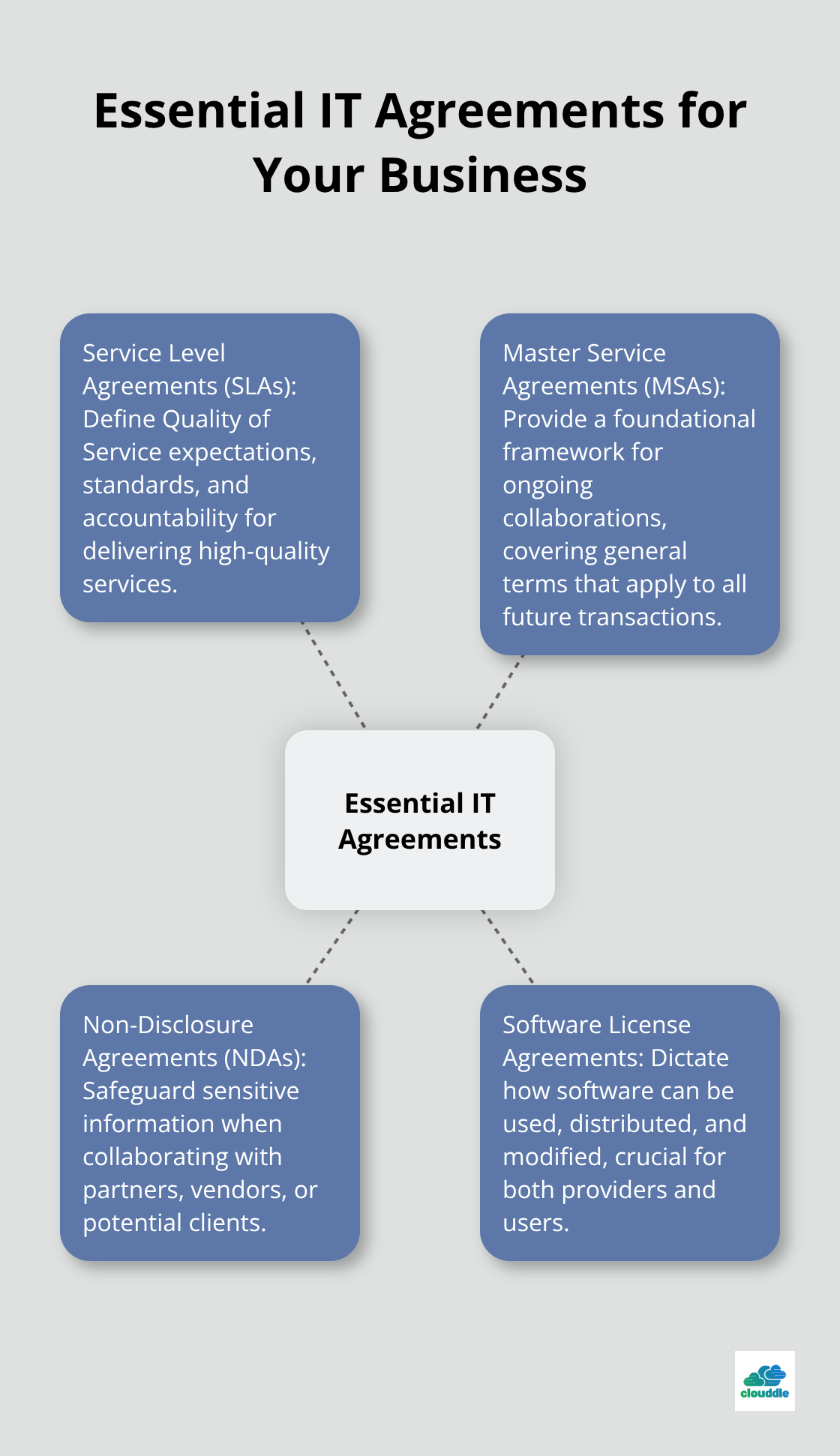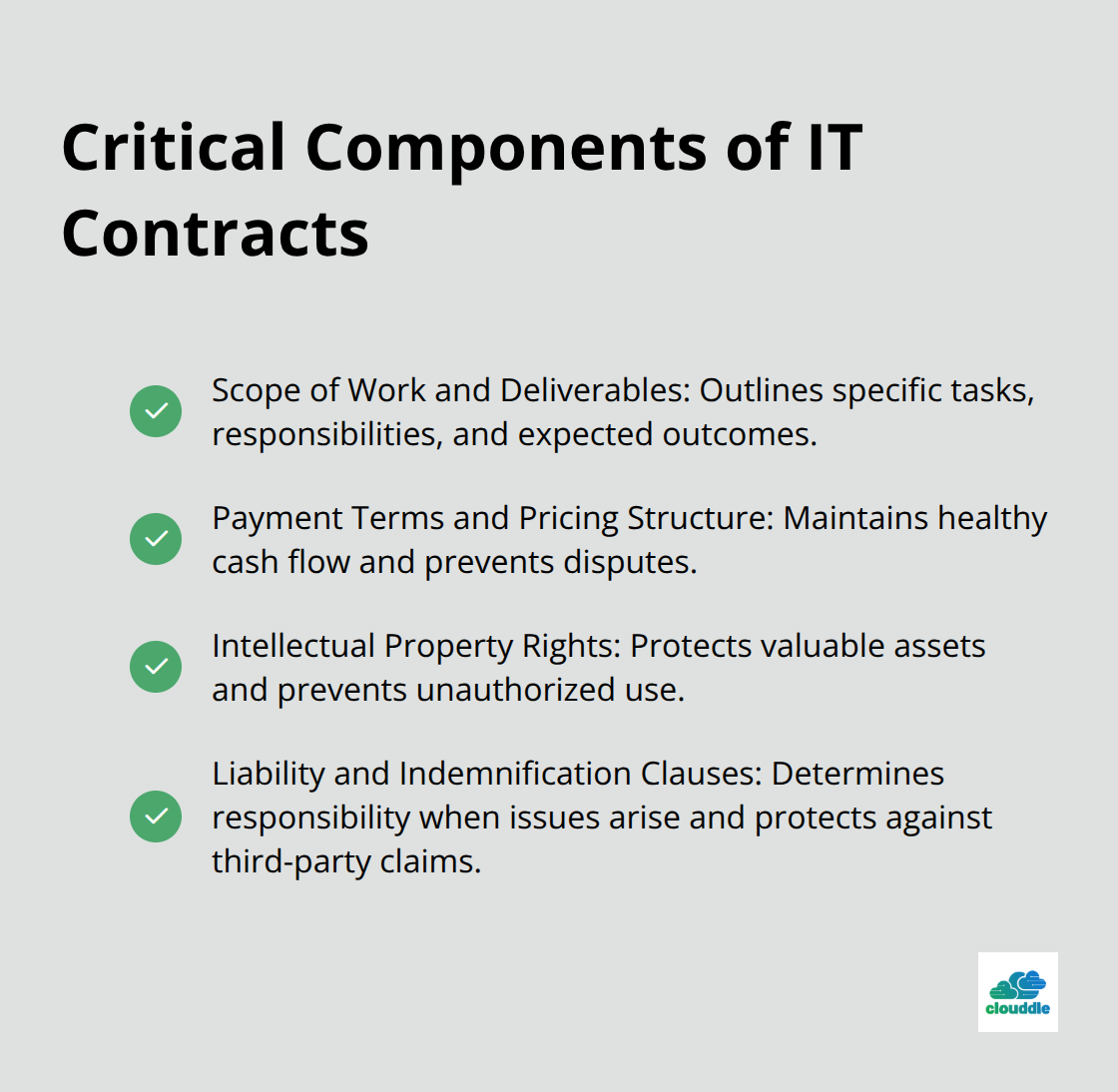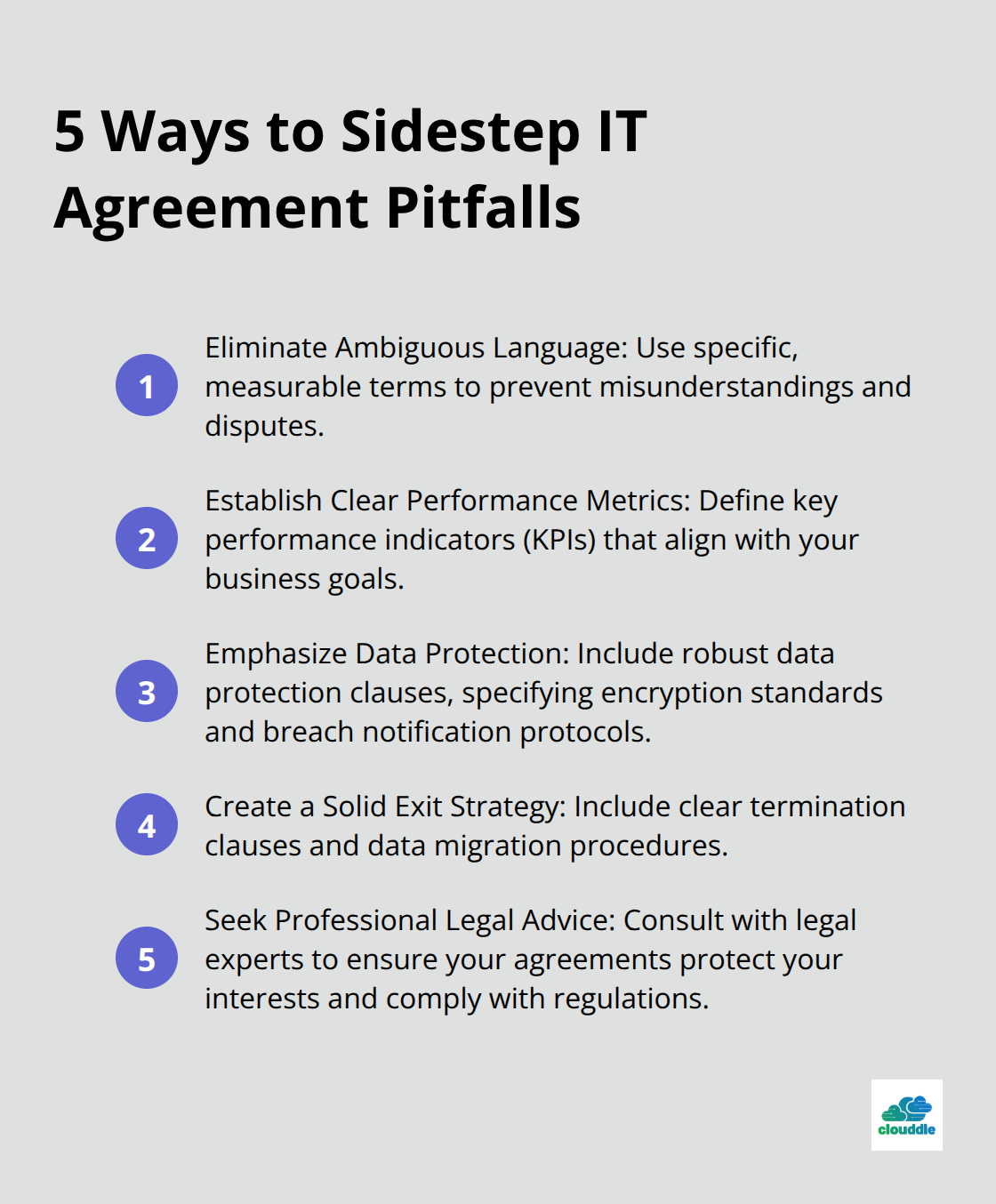IT agreements and contracts are the backbone of successful business relationships in the tech world. They define expectations, protect interests, and provide a roadmap for collaboration.
At Clouddle, we’ve seen firsthand how well-crafted agreements can make or break projects. This post will guide you through the essential IT contracts every business should understand and the critical components to include in them.
Key IT Agreements for Your Business
In the tech world, well-crafted agreements form the foundation of successful partnerships. Let’s explore four essential IT agreements that every business should have in their toolkit.
Service Level Agreements (SLAs)
SLAs define the Quality of Service (QoS) expectations, standards, and accountability, helping to deliver high-quality services. They form the foundation of managed IT services. A well-structured SLA includes specific, measurable metrics. You might specify 99.9% uptime for critical systems or a 4-hour response time for urgent issues.
When you negotiate an SLA, focus on metrics that directly impact your business operations. Include clear consequences for breaches and a process for regular performance reviews.
Master Service Agreements (MSAs)
MSAs provide a foundational framework for ongoing collaborations. They cover general terms that apply to all future transactions, which saves time and reduces legal costs.
A study by the International Association for Contract & Commercial Management (IACCM) found that MSAs provide a framework for pricing negotiations. When you draft an MSA, pay special attention to intellectual property rights, confidentiality clauses, and dispute resolution procedures. These elements often cause friction if not clearly defined upfront.
Non-Disclosure Agreements (NDAs)
In the fast-paced tech industry, protecting your intellectual property is paramount. NDAs safeguard your sensitive information when you collaborate with partners, vendors, or potential clients.
Your NDA should clearly define what constitutes confidential information, specify the permitted uses of that information, and outline the consequences of a breach.
Software License Agreements
These agreements dictate how you can use, distribute, and modify software. They’re crucial for both software providers and users. A poorly drafted license agreement can lead to unexpected costs or legal violations.
When you review a software license agreement, pay close attention to usage rights, maintenance terms, and any limitations on transferability or sublicensing.
These four agreements form the cornerstone of solid IT partnerships. They provide clarity, protect interests, and set the stage for successful collaborations. However, each agreement should be tailored to your specific business needs and reviewed by legal professionals to ensure comprehensive protection. Now, let’s examine the critical components that make these IT contracts effective and robust.

Critical Components of IT Contracts
At Clouddle, we understand the importance of well-crafted IT contracts. Let’s explore the key elements that make these agreements effective and robust.
Scope of Work and Deliverables
The scope of work forms the cornerstone of any IT contract. It outlines the specific tasks, responsibilities, and expected outcomes. A clear scope prevents misunderstandings and project creep.
We recommend the use of precise, quantifiable language. For instance, instead of “enhance website speed,” specify “reduce page load time to under 2 seconds for 95% of users.” This precision helps both parties understand expectations and measure success.
Payment Terms and Pricing Structure
Clear payment terms maintain healthy cash flow and prevent disputes. Milestone-based payments often work well for IT projects. Both milestone billing and project billing have benefits and drawbacks. The best choice will depend on your cash flow needs and the scope of the project at hand.
For ongoing services, consider monthly or quarterly billing cycles. Always specify payment methods, due dates, and late payment penalties.
Intellectual Property Rights
In the tech industry, intellectual property (IP) often represents a company’s most valuable asset. Protecting these assets through appropriate IP rights is vital to prevent unauthorized use, copying or exploitation by competitors.
For software development projects, specify whether the client will own the source code or just have a license to use the final product. If you use open-source components, ensure compliance with their licenses to avoid legal complications.
Liability and Indemnification Clauses
These clauses determine responsibility when issues arise. They’re complex but essential. Try to limit your liability where possible, but be prepared to take responsibility for your work.
Include indemnification clauses to protect against third-party claims. For example, if you provide software, you should indemnify the client against claims of copyright infringement.
While these components are essential, every IT contract is unique. Always tailor your agreements to your specific situation and seek legal advice when needed. A well-crafted contract sets the stage for successful partnerships and smooth project execution. Now, let’s turn our attention to common pitfalls in IT agreements and how you can avoid them.

How to Sidestep IT Agreement Pitfalls
Eliminate Ambiguous Language
Vague terms cause misunderstandings and disputes. The International Association for Contract and Commercial Management reports that unclear contract wording can lead to issues. Use specific, measurable language to prevent this issue. Replace “regular updates” with “bi-weekly updates delivered by email every other Friday by 5 PM EST.”
Establish Clear Performance Metrics
Many IT agreements lack concrete metrics, making it impossible to measure success or failure. Define key performance indicators (KPIs) that align with your business goals. For a cloud service, specify “99.99% uptime, measured monthly” or “response time under 200ms for 95% of requests.”
Emphasize Data Protection
Neglecting data protection can lead to catastrophic consequences in an era of increasing cyber threats. IBM’s Cost of a Data Breach Report provides up-to-date insights into cybersecurity threats and their financial impacts on organizations. Include robust data protection clauses in your agreement. Specify encryption standards (e.g., “AES-256 encryption for data at rest and in transit”), data handling procedures, and breach notification protocols (e.g., “notification within 24 hours of any suspected data breach”).
Create a Solid Exit Strategy
Many businesses focus solely on the start of the relationship, overlooking exit strategies. This oversight can result in costly and messy separations. Include clear termination clauses and data migration procedures. Specify how long the vendor will retain your data post-termination and in what format you’ll receive it (e.g., “All customer data will be provided in CSV format within 30 days of contract termination”).
Seek Professional Legal Advice
While these guidelines help create more robust IT agreements, every situation is unique. Consult with legal professionals to ensure your agreements protect your interests, address your specific needs, and comply with relevant laws and regulations.

Final Thoughts
IT agreements and contracts form the foundation of successful tech partnerships. They define expectations, protect interests, and guide collaborations. We explored key agreements, including Service Level Agreements, Master Service Agreements, Non-Disclosure Agreements, and Software License Agreements, along with their critical components.
Professional legal advice becomes invaluable when crafting these agreements. Legal experts can tailor contracts to specific needs, ensure compliance, and navigate complex negotiations. They help identify potential pitfalls and create robust agreements that drive business success.
Clouddle offers managed IT, networking, and security services with flexible contracts. Our Network as a Service (NaaS) solution combines cutting-edge technology with clear agreements (allowing businesses to focus on growth without infrastructure worries). Well-crafted IT agreements and contracts serve as strategic tools that foster innovation and build lasting partnerships in the fast-paced tech world.


